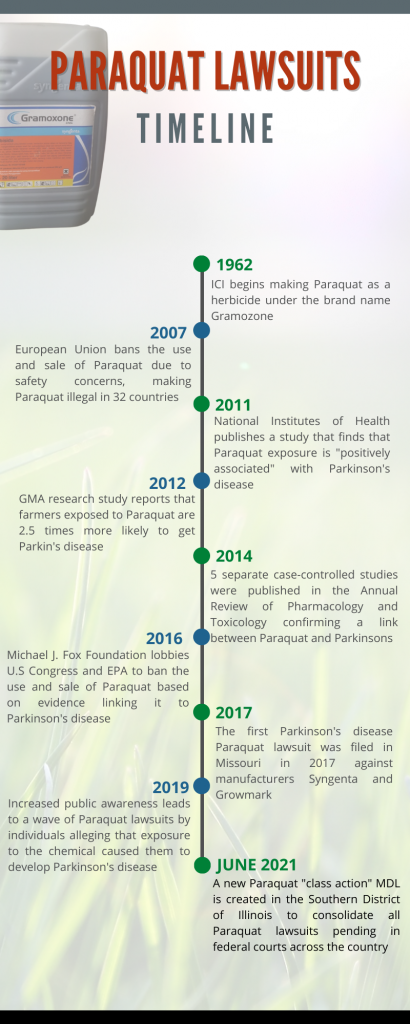Chief Judge Nancy J. Rosenstengel, who is the judge in the Paraquat MDL class action lawsuit, announced that the first Paraquat bellwether trial will start on November 15, 2022.
Is There a Paraquat MDL Class Action?
 There is a Paraquat MDL class action. This means that federal Paraquat lawsuits are consolidated into an MDL on June 8, 2021. The plaintiffs sued primarily Chevron and Syngenta. Their Paraquat lawyers alleged failure to warn and defective design. The plaintiffs claimed their exposure to paraquat caused them to develop Parkinson’s disease.
There is a Paraquat MDL class action. This means that federal Paraquat lawsuits are consolidated into an MDL on June 8, 2021. The plaintiffs sued primarily Chevron and Syngenta. Their Paraquat lawyers alleged failure to warn and defective design. The plaintiffs claimed their exposure to paraquat caused them to develop Parkinson’s disease.
2011 study on Paraquat’s associations with Parkinson’s
I want to talk in this post about the science that led to the Paraquat lawsuits.
In a 2011 Environmental Health Perspectives-published study, researchers examined paraquat and rotenone’s associations with Parkinson’s. They examined lifetime exposure to both substances. The researchers’ data showed paraquat and rotenone exposure was “positively associated” with Parkinson’s.
Parkinson’s risk in TBI patients with Paraquat exposure
A 2012 study showed associations between paraquat and Parkinson’s disease in traumatic brain injury (TBI) patients. UCLA researchers found that TBI patients were two times at risk for Parkinson’s than non-TBI patients, while paraquat exposure alone only slightly increased the Parkinson’s risk. They also found that TBI patients with significant paraquat exposure were three times more likely to develop Parkinson’s than non-TBI patients with no paraquat exposure.
Meta-analysis on pesticides’ association with Parkinson’s
Italian researchers discovered that pesticide and herbicide exposure increased the Parkinson’s risk. They looked at 104 studies that included several chemicals, including paraquat, mancozeb, and maneb. The researchers discovered that paraquat and maneb exposure was associated with a two-fold risk increase for Parkinson’s. The risk was higher for rural residents.
2007 EU ban on Paraquat
In July 2007, the European Union’s Court of First Instance reversed a 2003 decision that authorized Paraquat use. Sweden initially brought this action, alleging that the initial authorization failed to protect human and animal health and the environment. The court ruled that the authorization failed to protect human health but found no evidence that it failed to protect animal health.
Paraquat ban’s effect on South Korean suicide rate
The South Korean government phased out paraquat between 2011 and 2012. A 2016 study found that this action almost cut the country’s suicide rate in half. Researchers’ data showed reductions across all demographics. The greatest reductions were in men, elderly people, and rural residents. Researchers found that the ban did not negatively impact crop yields. They recommended that other countries implement similar measures to curb the suicide by pesticide rate.
March 2020 Paraquat Lawsuit in Illinois federal court
A Texas resident and his wife sued Chevron Phillips, Growmark, and Syngenta in March 2020. They filed suit in Illinois federal court. The man claimed he sustained Parkinson’s disease from years of paraquat exposure. He applied it while working as a crop duster in the late 1960s to early 1970s. The man was diagnosed with Parkinson’s in 2019. He alleged that the defendants failed to warn, designed a defective product, defrauded consumes, and breached warranties.
March 2021 Greenpeace report
A March 2021 Greenpeace report showed that Syngenta, paraquat’s manufacturer, and its predecessor, Imperial Chemical Industries (ICI), covered up the product’s toxicity. ICI publicly claimed that the herbicide included PP796 to prevent fatal poisoning. However, internal documents contradicted these claims. They revealed that the emetic levels were too low to induce vomiting.
Former Syngenta toxicologist Jon Heylings reported that paraquat contained PP796 levels that were too low to induce vomiting. He also reported that a former ICI toxicologist used falsified data that overestimated human sensitivity to the herbicide. Heylings’ memos to his superiors detailed these issues. He also recommended that the PP796 levels in paraquat be increased. Heylings argued that this would reduce the death by paraquat poisoning rate. ICI ignored his concerns. The PP796 levels in paraquat were now the global standard for other herbicides and pesticides.
May 2021 Clinical Toxicology report
In February 2018, Taiwan implemented its first-stage ban on producing and importing paraquat. Researchers found that pesticide and paraquat suicide rates in 2019 decreased by 37 and 58 percent, respectively. They found larger reductions in men, rural areas, and elderly individuals.
Despite finding no change in non-pesticide and overall suicides, the elderly suicide rate decreased by 10 percent. This showed that a significant amount of suicides committed by elderly individuals involved pesticides, including paraquat.
The researchers concluded that reductions in pesticide, Paraquat, and elderly suicide rates followed Taiwan’s paraquat ban.
 Maryland Lawyer Blog
Maryland Lawyer Blog

